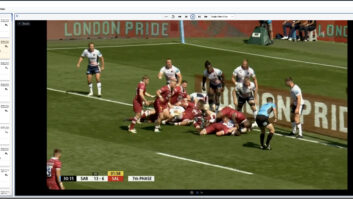
UTV – formerly Ulster Television – has provided UK channel three programmes to Northern Ireland since 1959. From its beginnings as one of the smallest stations on the ITV network, the organisation behind the channel has developed into a major player in the media market. Alongside the television operation, the group is involved with a number of radio stations in the UK and Ireland and new media businesses, writes Philip Stevens.
In October 2010 UTV HD, a simulcast of the SD transmissions was launched on Virgin Media – a service that will be extended to Sky and Freeview over the coming months. Despite its relatively small size, UTV has developed a number of systems to help production throughput. One of its most recent moves has involved the acquisition of an intelligent archiving solution. The purchase was organised by Dublin-based technology provider Tyrell CCT, and consists of Marquis’ Parking archive and retrieval software and a three node MatrixStore cluster from Object Matrix.
“This is an integral part of our move to a tapeless environment,” states Sean Ferrin, UTV’s head of Resources. “Two years ago UTV moved to a complete Avid newsroom system. Six months later we changed our acquisition format from tape to Panasonic P2 – and this made our newsroom completely tapeless.”
According to Ferrin, this not only produced significant benefits, but also some interesting challenges. “Initially, we continued to archive to tape, however we aspired to move to a file-based storage solution. Having said that, we did not want simply to archive the stories as flat files, but rather required a system that would enable us to recall a consolidated sequence complete with timeline and clips. To be honest, we weren’t sure if anyone produced such a system, but in the end it was a challenge we presented to Tyrell.”
Not only did Ferrin want the files to be stored with the relevant information, but the system needed to work across UTV’s media network. “Tyrell introduced us to Marquis who supplied the software solution and Object Matrix who offered its storage solution. The reason we chose Object Matrix is that it is a cluster server that provides the absolute redundancy required for a long-term archive. Also, the cluster can be expanded with no system management required.”
Stuart Lawn, technical director at Tyrell, takes up the story. “This was a fascinating challenge as it involved two manufacturers who had not previously collaborated. But we knew there was a benefit to UTV of a scalable storage solution that didn’t have the term ‘SAN’ in the concept.
“Once we had settled on Marquis and Object Matrix we got the two companies talking fairly quickly and I believe we were the first reseller to pair them up in a solution. Since then, the companies have exchanged engineering visits and developed a unified marketing approach.”
He adds, “We did look at some other suppliers, but it was obvious that most couldn’t produce a cost effective system, or, perhaps more significantly, the specification that would be of use to UTV in the short term.”
Lawn states that the solution offered by Marquis Broadcast provided a simple end user interface that did exactly what UTV required without huge amounts of setup time. At the same time, Object Matrix presented cost effective storage that could be scaled easily. In addition, the capability of the system’s P2 workflow with DropSpot was attractive as an added bonus. DropSpot is a secure and flexible archive and workgroup desktop application that interfaces with MatrixStore API. Using this application, it is possible to archive, write, read, search and delete to MatrixStore – the central repository for the archived packages.
In short, the solution offered by the two suppliers enables the broadcaster to move entire sequences, including edit decisions, subclips and metadata from its Avid ISIS storage to the MatrixStore system with a ‘one-click’ process. It also means that footage, along with all metadata including media and edit decisions, can be retrieved and dropped directly into the Avid system. This storage array currently provides UTV with 32TB of nearline storage – but with a capability of considerable future archive capacity.
Easy search
Ferrin states that UTV maintains a mirrored low resolution proxy of ingested material that is available on the house network. “Each day, the library enters details of the previous 24 hours’ ingest. This allows the journalists to perform a search in iNews or using Strix archive search engine. They can then easily view the material at their desktop and, having identified their requirements, request the library staff to retrieve the high resolution version and place it into the current Avid work space. As far as news stories are concerned, we never delete any material.”
As with any system a certain amount of adjustment was required to tailor the set-up to the existing workflow. However, the end result is an archive process that is simple. It involves the library staff dragging the required sequence and dropping it over the archive icon. UTV also trained the library staff to edit – allowing them to clip up live interviews and material identified by the newsroom.
Alongside the archive solution, UTV took the opportunity to expand its Avid system to meet new requirements. This involved an expansion of the ISIS storage system with additional blades and chassis that quadrupled the broadcaster’s storage requirements. In addition, two HD Airspeed units were acquired to handle input into the Avid ISIS media network and provide extra capacity that allows UTV to increase its playback and recording of HD material within its transmission suite.
“We have recently launched our HD service and are currently configuring a new automation and full HD playout system,” says Ferrin. “In January we took delivery of a 3ME fully-loaded Kahuna HD studio vision mixer with a satellite 1ME panel and our intention is to order a replacement HD router and two new multi-screen systems for the studio and Transmission Control. We also have three new HD Omneon servers — one for prep and two for commercial and programme playout.”
He concludes, “Our archive solution has been a success. In fact, I have ordered another Object Matrix server to use for near online storage.”
UTV – formerly Ulster Television – has provided UK channel three programmes to Northern Ireland since 1959. From its beginnings as one of the smallest stations on the ITV network, the organisation behind the channel has developed into a major player in the media market. Alongside the television operation, the group is involved with a number of radio stations in the UK and Ireland and new media businesses, writes Philip Stevens.
In October 2010 UTV HD, a simulcast of the SD transmissions was launched on Virgin Media – a service that will be extended to Sky and Freeview over the coming months. Despite its relatively small size, UTV has developed a number of systems to help production throughput. One of its most recent moves has involved the acquisition of an intelligent archiving solution. The purchase was organised by Dublin-based technology provider Tyrell CCT, and consists of Marquis’ Parking archive and retrieval software and a three node MatrixStore cluster from Object Matrix.
“This is an integral part of our move to a tapeless environment,” states Sean Ferrin, UTV’s head of Resources. “Two years ago UTV moved to a complete Avid newsroom system. Six months later we changed our acquisition format from tape to Panasonic P2 – and this made our newsroom completely tapeless.”
According to Ferrin, this not only produced significant benefits, but also some interesting challenges. “Initially, we continued to archive to tape, however we aspired to move to a file-based storage solution. Having said that, we did not want simply to archive the stories as flat files, but rather required a system that would enable us to recall a consolidated sequence complete with timeline and clips. To be honest, we weren’t sure if anyone produced such a system, but in the end it was a challenge we presented to Tyrell.”
Not only did Ferrin want the files to be stored with the relevant information, but the system needed to work across UTV’s media network. “Tyrell introduced us to Marquis who supplied the software solution and Object Matrix who offered its storage solution. The reason we chose Object Matrix is that it is a cluster server that provides the absolute redundancy required for a long-term archive. Also, the cluster can be expanded with no system management required.”
Stuart Lawn, technical director at Tyrell, takes up the story. “This was a fascinating challenge as it involved two manufacturers who had not previously collaborated. But we knew there was a benefit to UTV of a scalable storage solution that didn’t have the term ‘SAN’ in the concept.
“Once we had settled on Marquis and Object Matrix we got the two companies talking fairly quickly and I believe we were the first reseller to pair them up in a solution. Since then, the companies have exchanged engineering visits and developed a unified marketing approach.”
He adds, “We did look at some other suppliers, but it was obvious that most couldn’t produce a cost effective system, or, perhaps more significantly, the specification that would be of use to UTV in the short term.”
Lawn states that the solution offered by Marquis Broadcast provided a simple end user interface that did exactly what UTV required without huge amounts of setup time. At the same time, Object Matrix presented cost effective storage that could be scaled easily. In addition, the capability of the system’s P2 workflow with DropSpot was attractive as an added bonus. DropSpot is a secure and flexible archive and workgroup desktop application that interfaces with MatrixStore API. Using this application, it is possible to archive, write, read, search and delete to MatrixStore – the central repository for the archived packages.
In short, the solution offered by the two suppliers enables the broadcaster to move entire sequences, including edit decisions, subclips and metadata from its Avid ISIS storage to the MatrixStore system with a ‘one-click’ process. It also means that footage, along with all metadata including media and edit decisions, can be retrieved and dropped directly into the Avid system. This storage array currently provides UTV with 32TB of nearline storage – but with a capability of considerable future archive capacity.
Easy search
Ferrin states that UTV maintains a mirrored low resolution proxy of ingested material that is available on the house network. “Each day, the library enters details of the previous 24 hours’ ingest. This allows the journalists to perform a search in iNews or using Strix archive search engine. They can then easily view the material at their desktop and, having identified their requirements, request the library staff to retrieve the high resolution version and place it into the current Avid work space. As far as news stories are concerned, we never delete any material.”
As with any system a certain amount of adjustment was required to tailor the set-up to the existing workflow. However, the end result is an archive process that is simple. It involves the library staff dragging the required sequence and dropping it over the archive icon. UTV also trained the library staff to edit – allowing them to clip up live interviews and material identified by the newsroom.
Alongside the archive solution, UTV took the opportunity to expand its Avid system to meet new requirements. This involved an expansion of the ISIS storage system with additional blades and chassis that quadrupled the broadcaster’s storage requirements. In addition, two HD Airspeed units were acquired to handle input into the Avid ISIS media network and provide extra capacity that allows UTV to increase its playback and recording of HD material within its transmission suite.
“We have recently launched our HD service and are currently configuring a new automation and full HD playout system,” says Ferrin. “In January we took delivery of a 3ME fully-loaded Kahuna HD studio vision mixer with a satellite 1ME panel and our intention is to order a replacement HD router and two new multi-screen systems for the studio and Transmission Control. We also have three new HD Omneon servers — one for prep and two for commercial and programme playout.”
He concludes, “Our archive solution has been a success. In fact, I have ordered another Object Matrix server to use for near online storage.”





